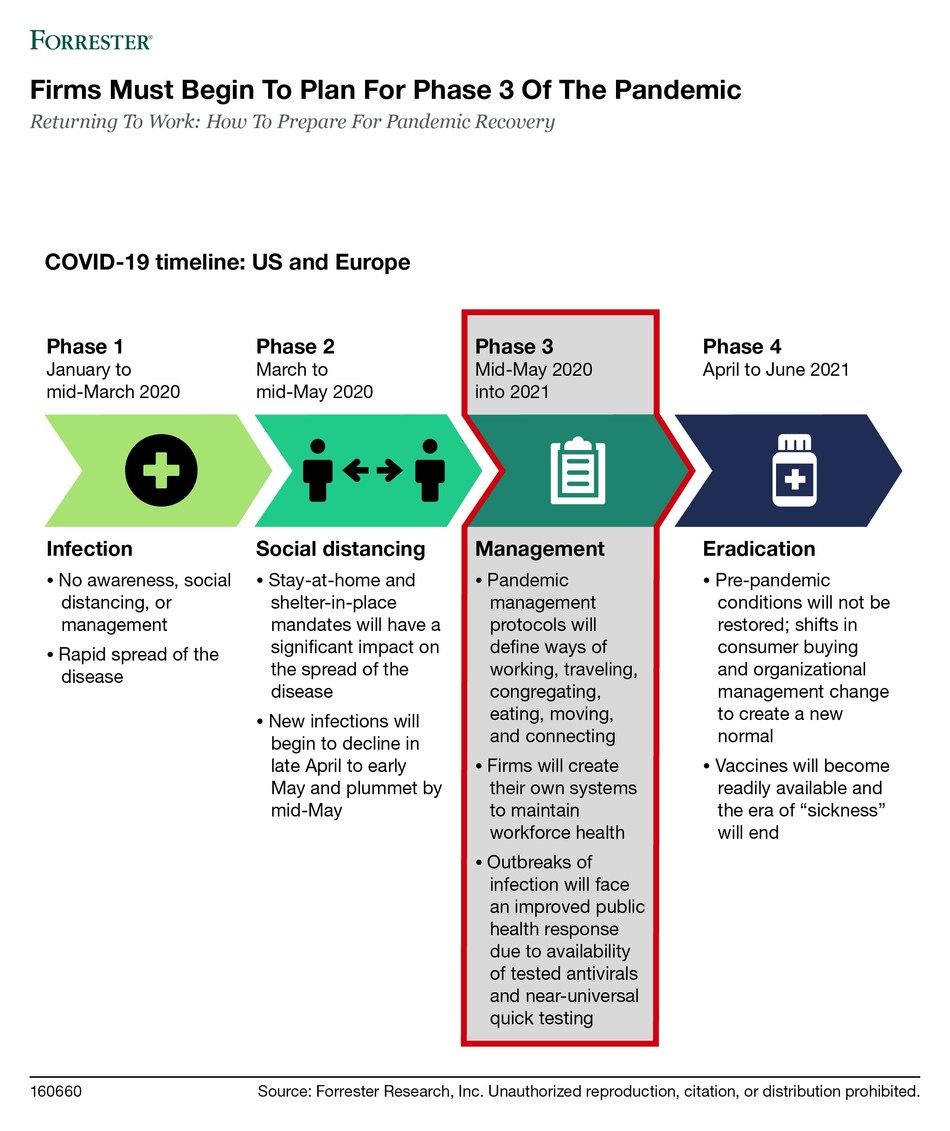As many countries enter phase three of the coronavirus, pandemic management protocols (PMPs) will define how we work, travel, congregate, and connect as a society.
According to Forrester, many countries across North America and Europe are entering phase three (management) of the coronavirus pandemic, expected to last from mid-May through the end of the year 2020 and into the year 2021. During this phase, pandemic management protocols (PMPs) — ways of working, traveling, socially congregating, and connecting — will have to be constructed and maintained by governments, companies, schools, and all organizations in society. Forrester says that if phase three is mismanaged by companies, states, and federal governments, these countries will not drop back to phase two (social distancing) — they will loop back to phase one (infection) and start the recovery process from the beginning. This will risk a year-long disruption of the economy rather than the three-month disruption caused by phase two.
HR Technology News: Randstad Risesmart Scales Quality and Consistency With the Launch of Global Training and Certification Platform.

In a new report, “Returning To Work: How To Prepare For Pandemic Recovery,” released today, Forrester further states that as the epicenter of the pandemic shifts around the world and each affected region reaches its peak infection rate, firms must prepare now to restart closed plants, reopen retail locations, and bring employees back to work. Planning pandemic recovery is particularly challenging, however, given the uncertain duration of the event and the risk of ongoing disease outbreaks and relapse but, most importantly, because it requires a focus on carefully managing the health, safety, and well-being of employees, customers, partners, and the community itself.
“A general business recovery plan is only helpful in dealing with disruptions caused by an extreme weather event or an IT failure,” said Stephanie Balaouras, vice president and group research director at Forrester. “A pandemic recovery, just as with pandemic planning, requires its own unique response because disease outbreaks can subside and then flare up again. Since this global pandemic is the first in 10 years, and only the second in 50 years, organizations need guidance on how to quickly close and reopen their operations if there is a new burst of infections or a second wave.”
HR Technology Interview: TecHR Interview with Bhaskar Roy, Head of Growth at Workato
Given the uncertainty, Forrester recommends a phased approach to recovery. According to Forrester, organizations must establish pandemic management protocols before returning employees to work. Key pandemic recovery planning measures include:
- Returning employees back to work in stages to minimize risk. Organizations will reduce the financial risk of reopening retail locations, plants, and other facilities before demand resumes as well as to reduce the risk of infection.
- Rethinking and reconfiguring physical spaces to safeguard employee well-being. Globally, regulatory bodies such as the Occupational Safety and Health Administration are publishing risk frameworks to guide employers on how to protect employees during COVID-19.
- Leveraging digital to pivot to new opportunities. Any merchant that does not already have a digital presence must invest in it now. Also, utilize digital to pivot to new revenue models.
- Aligning business priorities and working closely with the CFO to plan a full return to capacity. Key decisions about when, how, and how many employees return to work will be based on the firm’s financial viability. A recovery plan will require CFOs to determine financial viability thresholds and balance cost-cutting countermeasures with operational requirements of the business.
- Maintaining continuous communication with all key audiences — especially employees. The communication strategy should clearly outline how the organization will communicate before, during, and after the pandemic. It should dictate the actual channels, modes of communication, and the frequency of communication.
- Building business resiliency as a competitive advantage. Resilient companies — those that can deliver on their vision and mission no matter the crisis or disruption — will build a strategy and framework for risk identification and mitigation; thorough business continuity planning and preparedness; flexible crisis and incident response capabilities; and business systems and supply chains designed for redundancy and dependability.
HR Technology News: PeopleKeep Releases Third Annual Report Detailing User Trends For The Qualified Small Employer HRA

